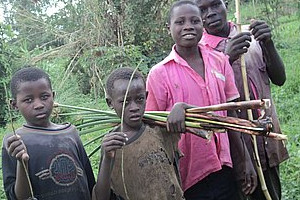Wetlands

Wetlands can be considered as sinks into which surface water or groundwater flows from a surrounding catchment. Within landscapes they are “natural harvesters” of rainwater and, by definition, sites where water occurs at or close to the ground surface.
However, wetlands are disappearing more and more. For instance, about 50% of South Africa’s wetlands have already been destroyed or converted through draining, the building of dams, incorrect burning and overgrazing, invasive alien species, waste disposal, water abstraction, agricultural, urban development and inappropriate land management. These losses are expected to increase as the human population grows and demand for water resources and land expands.
Rural communities obtain direct benefits from wetlands when they harvest reeds for crafts, grow crops in wetland fields and extract water for drinking. They also obtain medicinal plants from wetlands, and at least 70% of South Africans are believed to use traditional medicine as their primary form of health care. Wetlands are also important carbon sinks, playing a key role in mitigating climate change.
Field experiences
In Vientiane, the capital of Lao PDR, wetlands offer flood attenuation and wastewater treatment services valued at USD 2 million per year. It has been estimated that these ecosystem services constitute investment savings of more than USD 18 million in damage costs avoided and USD 1.5 million in the artificial technologies that would be required to fulfill the same functions.
In Uganda alone, the use of inland water resources is worth almost USD 300 million a year in terms of forest catchment protection, erosion control and water purification services. Almost 1 million urban dwellers rely on natural wetlands for wastewater retention and purification services. Work carried out in the Zambezi Basin in Southern Africa shows that natural wetlands have a net present value of more than USD 64 million. That is USD 16 million in terms of groundwater recharge, USD 45 million in terms of water purification and treatment services and USD 3 million in reducing flood-related damage costs.
- To read more, go here: MAKING WATER A PART OF ECONOMIC DEVELOPMENT PDF.
Akvo RSR Projects
The following project(s) enable wetlands use as a water source.
 Wetland Management & Water Harvesting |
Manuals, videos and links
- Drought in eastern Africa worsened by wetland loss. Wetlands International, 2009.
- Land and Water Use of Wetlands in Africa: Economic Values of African Wetlands. Kirsten Schuijt. International Institute for Applied Systems Analysis. September 2002.
- ECONOMIC VALUE OF THE ZAMBEZI BASIN WETLANDS. Jane Turpie, Brad Smith, Lucy Emerton, et al. University of Cape Town. December 1999.
Acknowledgements
- McCartney, M.; Rebelo, L-M.; Senaratna Sellamuttu, S. et al. Wetlands, Agriculture and Poverty Reduction. or direct link to PDF. IWMI, 2010.
- Why Wetlands Matter | A media Release from The EWT. The Endangered Wildlife Trust (EWT). Posted 2010.
- MAKING WATER A PART OF ECONOMIC DEVELOPMENT: The Economic Benefits of Improved Water Management and Services. Stockholm International Water Institute, SIWI. Governments of Norway and Sweden.
